February 24, 2014 |
BITE: My Journal
Masa Writes the Book of Sushi

If you have to ask the price, you can’t afford this gossamer fatty toro and caviar.
Tonight’s seduction at Masa arrives with little preamble. It’s a majestic blast, gleaming black caviar on a hill of fatty Bluefin toro. The two small rectangles of toast alongside are so perfectly cut -- little brown Band-Aids -- they could be made of porcelain. The mingle of sweet and salt and fat is so powerful as I lick it slowly from the small black wooden spoon.
The caviar is from California. “American caviar is so good now,” the chef and my host tonight agree.
I’ve already forgotten a certain weird sea taste of the chewy hamaguri clam that launched this evening’s tasting in a puddle of sake broth with mitsuba greens. I need another toast. Isn’t that obvious? I dare not ask. I take turns with the spoon, a dab of pink, a dab of black, toro then caviar, then toro and caviar. Then it is gone. It almost lasted forever.
There is a silence, a dazed recovery, and then the sharp wakeup clarity of triggerfish curls with grated daikon in a ponzu sauce with citrus tang and a tangle of powerful sprouts.
 At first I was upset when I didn’t see Masa anywhere, but the place had a lovely vibe.
At first I was upset when I didn’t see Masa anywhere, but the place had a lovely vibe. I was on edge -- should I say, discombobulated? My globe-circling Daddy Warbucks dropped back to sea level this month and invited me to Masa. Yes, I guess that was what I was waiting for: an invitation. It’s my first time back to this clean-sanded wooden counter since the night Masa opened in the Time Warner complex in 2004 and I was the guest of the architect Richard Bloch. The prix fixe was $300 then. Now it’s $450 before tax, tip or drink. But the 1% are richer than ever. And the nation’s number of billionaires has multiplied since then too. No need to worry about Masa. The hostess consults her list and asks us to turn off our phones.
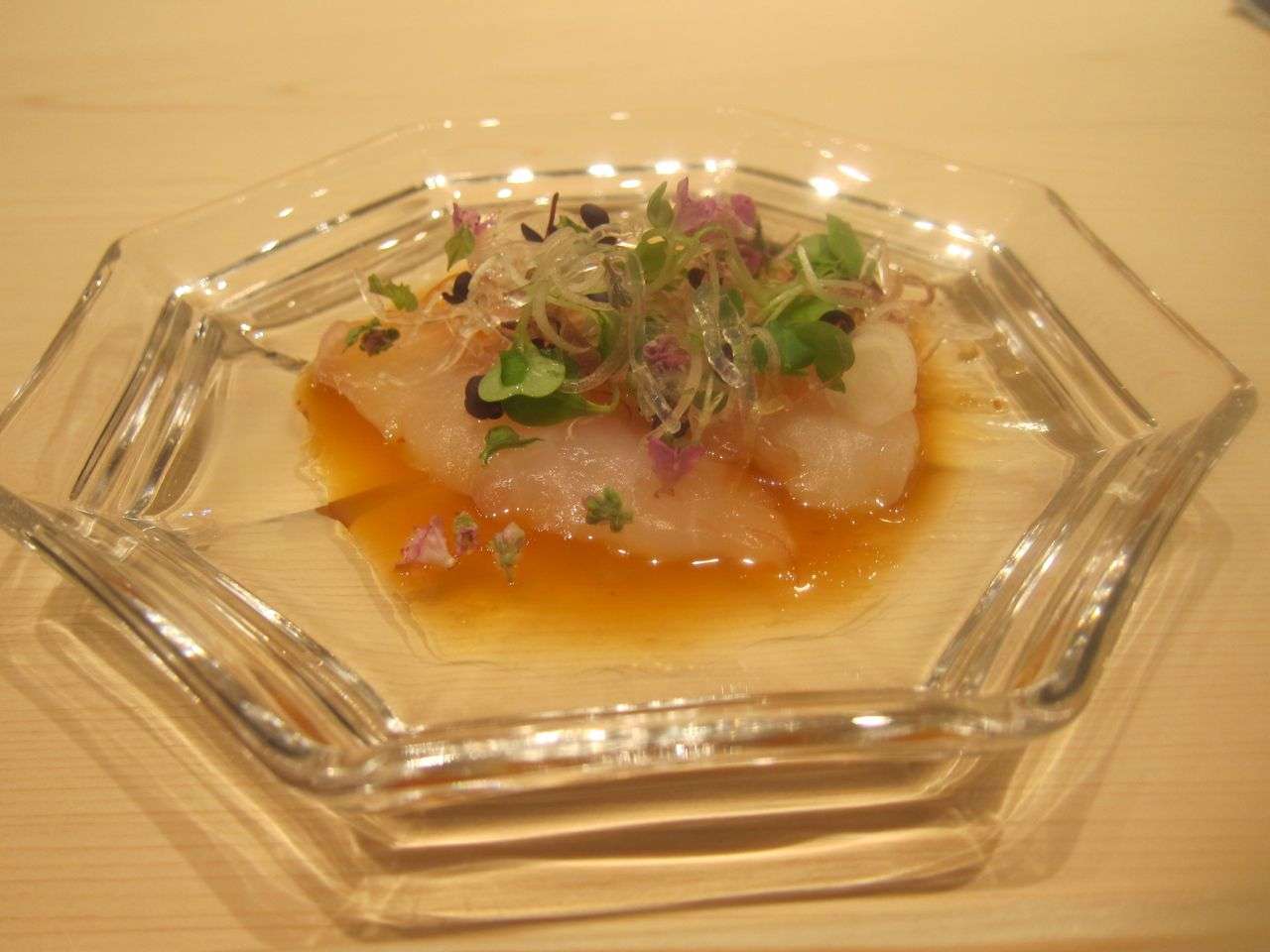 Tendrils of triggerfish swim in glorious ponzu sauce with a powerful citrus tang.
Tendrils of triggerfish swim in glorious ponzu sauce with a powerful citrus tang. My host is about to invest $1,600 or so (I’m guessing) for this evening of anticipated sensual enlightenment at Masa’s ten-seat bar. (I won’t ask how much. He is too elegant to say.) Shouldn’t Masayoshi Takayama be here?
I’d almost forgotten the windowless, rather beige space, austere and elegant, the cushy leather seats, the vast expanse of fresh-sanded hiroko wood in front of us, the slab of tree for a door, a big explosion of blossoms along one wall bringing spring in this polar winter.
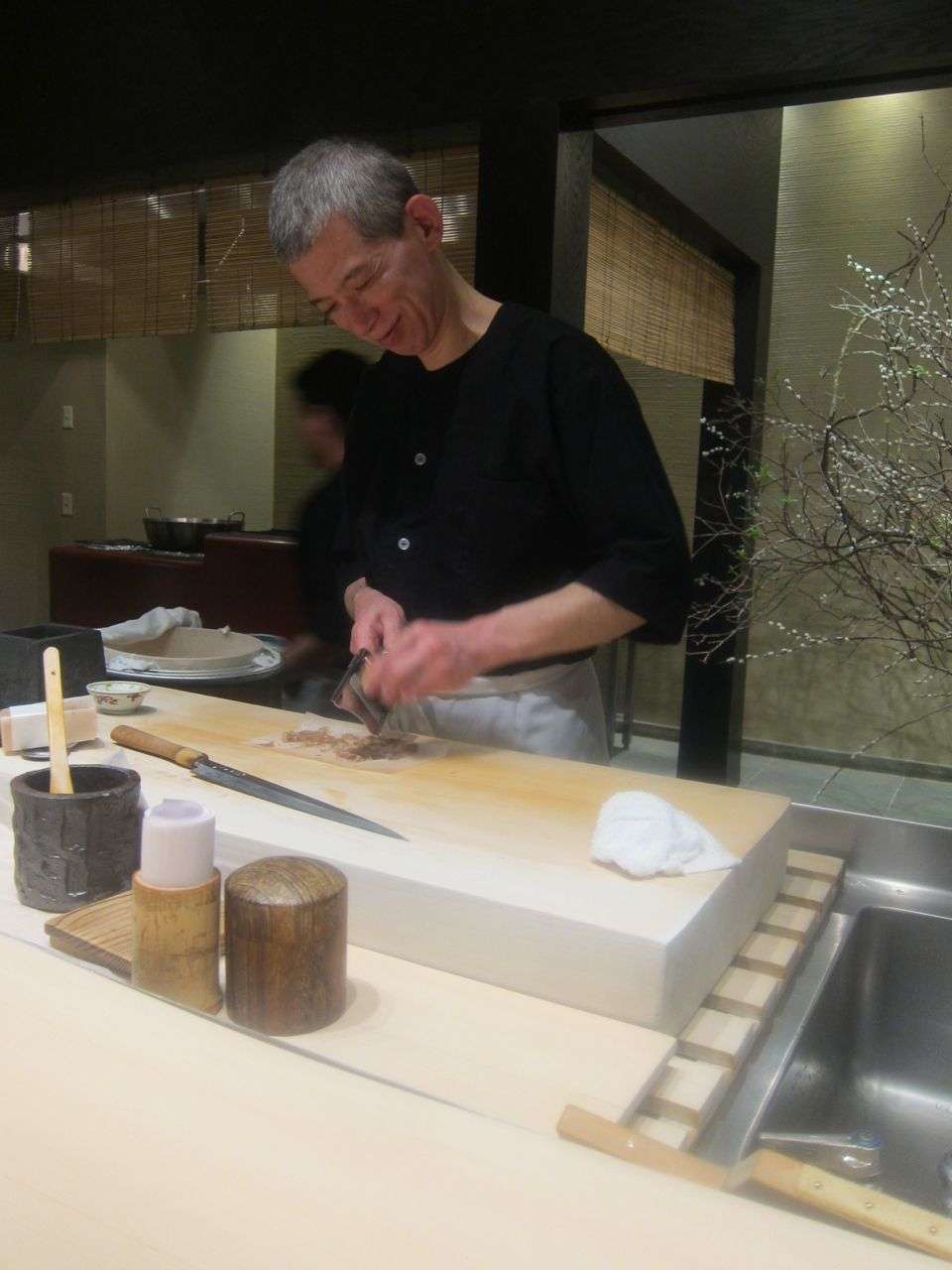 We basked in the warmth and ease of the chef in charge, Yasunori Fujimoto.
We basked in the warmth and ease of the chef in charge, Yasunori Fujimoto. There is no sign of Masa. I’m ready to be annoyed, but patrons more faithful than I have discovered the charm of Masa’s longtime second, Takahiro Sakaeda, and the relaxed ease of Yasunori Fujimoto, with his close-clipped hair and loose, collarless black shirt, who is in charge of our case tonight. A dapper young man pours Junmai “Akita Issui” ($139) into two small, plain glasses. “Reasonable,” my companion informs me, “considering the quality and how fresh.”
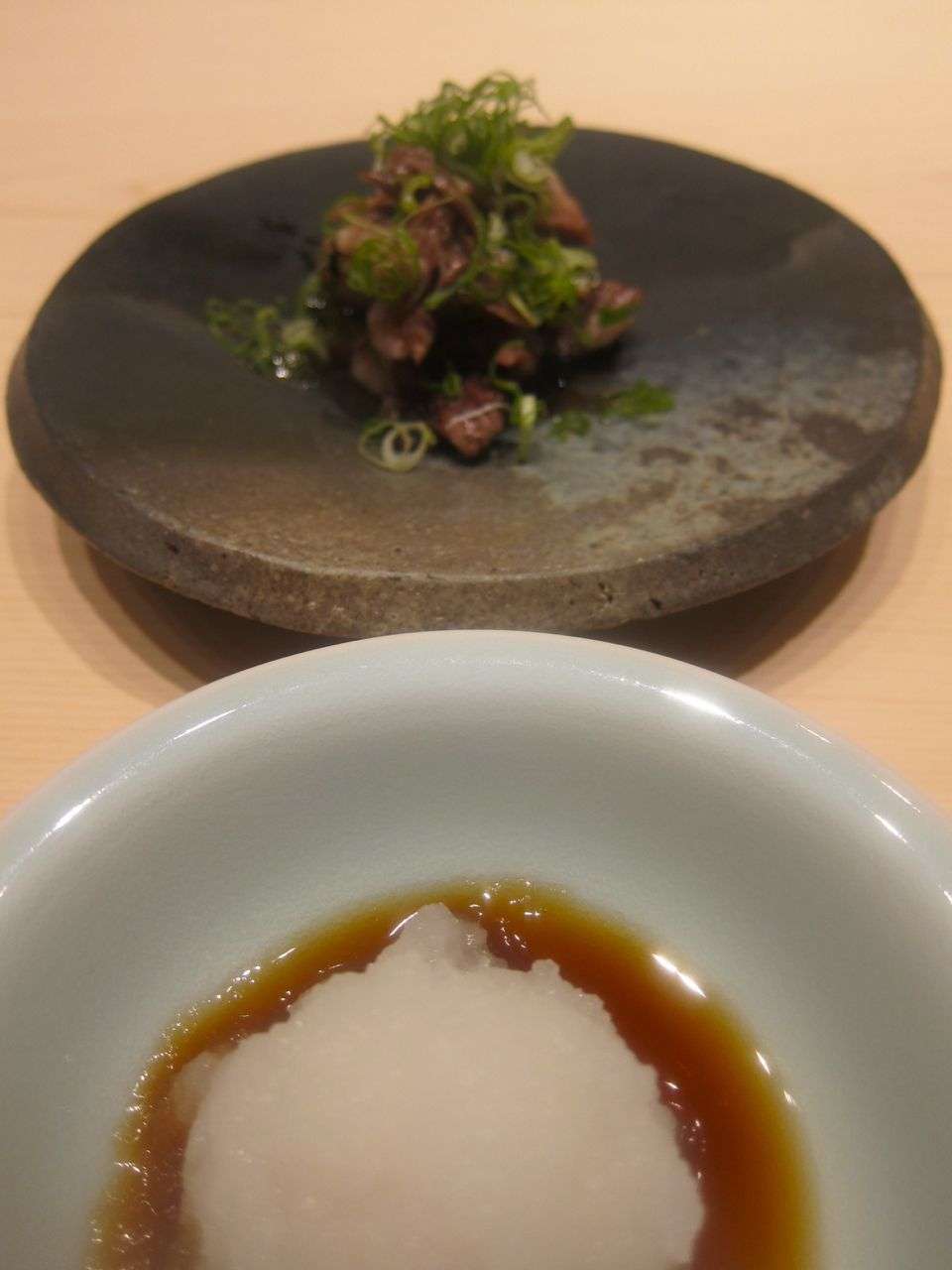 Tuna sinew tossed with scallion is about texture. Fresh grated daikon is a taste thrill.
Tuna sinew tossed with scallion is about texture. Fresh grated daikon is a taste thrill. I’ve surrendered my edge, focusing on the opening act now. Kama, the tough parts of tuna, grilled and tossed with scallion, seem to be about texture. Shall I mix it with the accompanying mound of fresh grated radish, cool and vibrant? Clearly, that is about taste. “This is the best time of year for the freshness of daikon,” my friend observes.
Steamed king crab in the shell sets my host to reminiscing about how wonderful a moment it would be in Kyoto during the crab season. Am I a pill? Yes, it’s crab -- not the best crab I’ve ever tasted, perhaps even a bit too cooked.
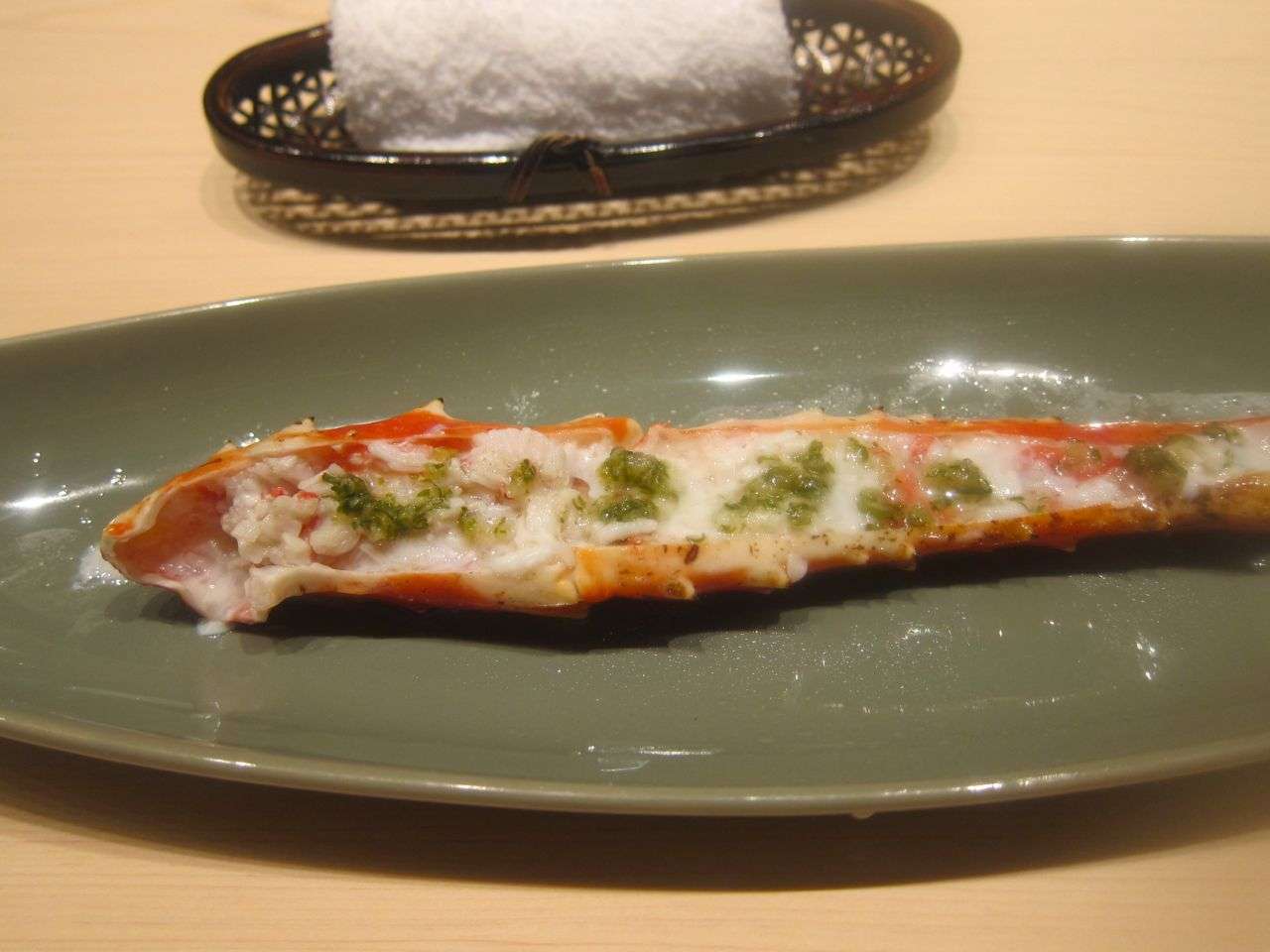 Precious snow crab reminds both my host and the chef of crab season in Kyoto.
Precious snow crab reminds both my host and the chef of crab season in Kyoto. The two men are speaking Japanese now, leaving me to my own fond cuisinary memories of Kyoto, and to the small wooden cup that has arrived with its powerful, intensely fragrant mushroom consommé. I tackle it with another wooden spoon, fishing a small mushroom cap and a bright green leaf from the bottom, then sip the rest.
Will we have the $150 optional Wagyu beef tataki with black truffles? What a silly question. Of course we will. What is another $300 for two ounces of otherworldliness? This is real Wagyu from Japan, only recently allowed into the country again after years of being banned.
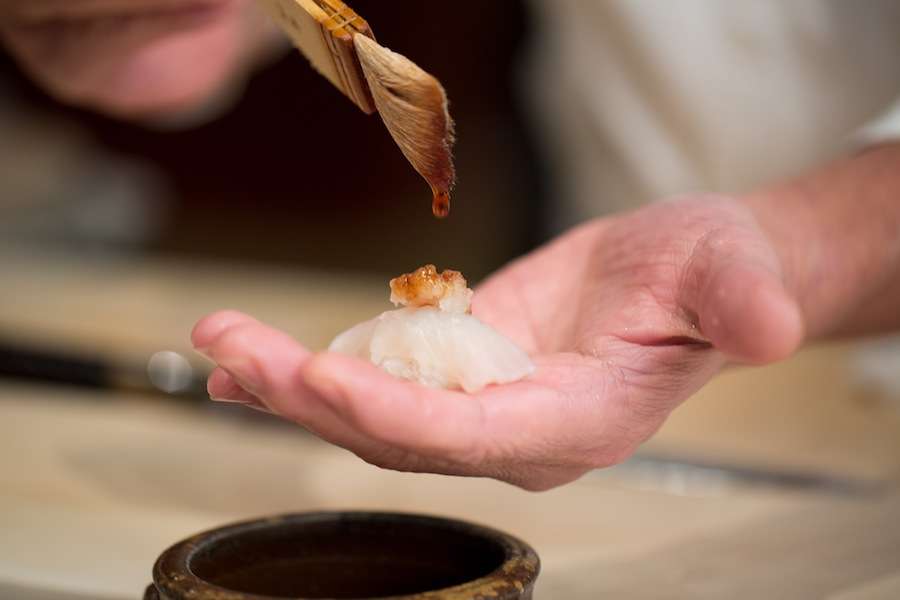 Masa was nowhere to be seen on my visit but these are his hands preparing hirame sushi.
Masa was nowhere to be seen on my visit but these are his hands preparing hirame sushi. I take the first bite, a sheer slice of raw beef and a black disc of truffle. A gasp of astonishment. The silken fat, its delicacy and sweetness. The subversive earthiness of truffle. The two of us divide the slices, how many…it seems ever-so-slightly meager, but it’s strangely filling. There is one gossamer tissue left. My impeccable escort insists it belongs to me. I don’t protest, not for a moment. Even after several bites, this last morsel is newly thrilling. (Sorry, I was asked to put my camera away.)
There is a suitable pause. And then, sushi.
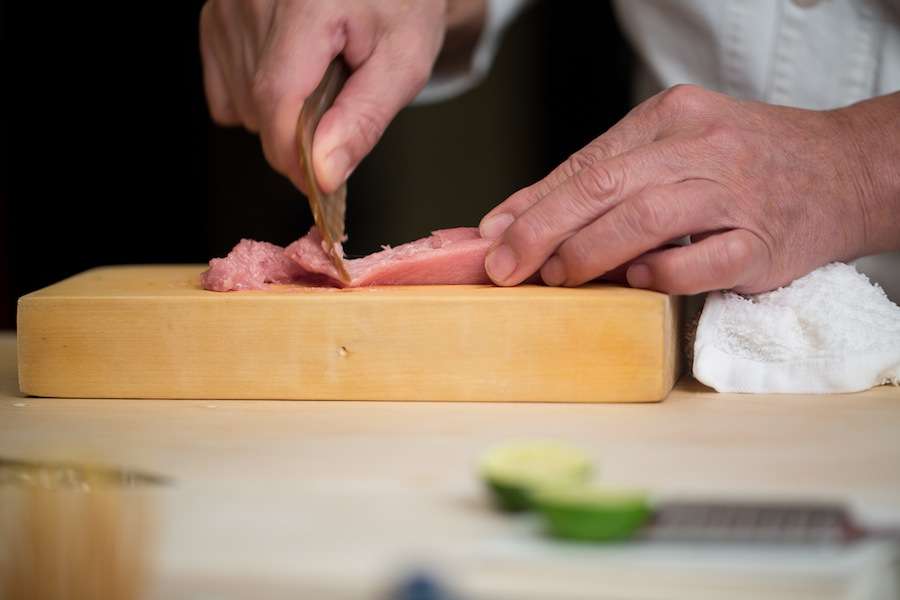 Chef Masa scrapes tuna from the skin with a clam shell.
Chef Masa scrapes tuna from the skin with a clam shell. Did you know that the Japanese do not drink sake with sushi? I had not heard that before. My host who visits Japan every few months informs me. I do prefer red wine with sushi. But no wonder, with the Japanese economy having the vapors and its citizens leaning toward wine and beer, the government is spending money to promote sake for the first time. They’re hoping Americans will give it a rush.
 I was asked to stop taking photos and Masa sent this of himself slicing grilled unagi.
I was asked to stop taking photos and Masa sent this of himself slicing grilled unagi. Would you start with tuna? Perhaps you’d save it for a climax. But Fujimoto sees it as rising action. Then, in a measured pace, comes fluke, striped jack, seabream, cool and firm -- all on warm rice, with various paintings. There is just a small bundle of warm rice below, with the fish dangling over or, in some cases, so stiff and fresh it sails straight out in the air. Sometimes I can taste the heat of wasabi between the fish and its saddle.
There is tinglingly fresh pickled ginger on my plate but no wasabi. I ask for some “to clear my palate.” The chef smiles, seizes a gnarled root and a measure of sharkskin to grate it on. He holds out the sharkskin for me to touch, then scoops up some green paste for my plate.
Is it the Goldeneye snapper or the needlefish that shakes me up? The firm bite. Even firmer resistance of squid follows. And then sweet shrimp in a soft and sticky huddle. The scallop is lightly cooked, not wildly exciting. I don’t remember the grilled toro sinew, but the menu says we had it. There is toasted shitake on rice too. Freshwater eel follows seawater eel, neither remarkable.
And then there is uni, four plump critters on a thin rubble of rice in an open curl of toasted nori. Most of Masa’s fish is supposedly flown in from the Tokyo market a few times a week. But Fujimoto observes that he likes the sea urchin of Santa Barbara better than Japan. My host agrees.

Torn shiso inside a curl of lotus root with a dab of ume paste makes a refreshing digestif.
We have watched him shave white truffle on rice for the trio of tourists who were seated when we arrived. Now he reaches for a fresh white truffle, grating it on a handful of rice, moistening it with sesame oil. I wave the vapors toward my nose. It’s a truffle that needs slow savoring. Next quickly comes negitoro, tuna belly with scallion in a roll, cut into fours. The chef suggests we dip the wrapper into the unused soy.
Chopped shiso wrapped in a thin sliver of white lotus root, with a dab of rose-colored ume (“Apricot, not plum”) is like the digestif in a French meal, my companion comments. “And shiso is an antibiotic.”
Will we have dessert? Of course I should. Who knows how long it will be before I am back. But I feel I can’t eat another bite. A woman steps in on my left to set down a big bowl. I dip my hand and just as my fingers rise to clear the edge, the bowl is gone. The check arrives. A credit card is whisked away. Various minions bring coats and hats. I ask to have a menu of what we’ve eaten emailed. It’s not quite as rich as Downton Abbey, but this is New York and it will do.
Time Warner Center, 10 Columbus Circle, fourth floor 212 823 9800. Monday through Saturday. 11:30 to 11 pm. Closed Sunday.
Photographs may not be used without permission from Gael Greene. Copyright 2014. All rights reserved.